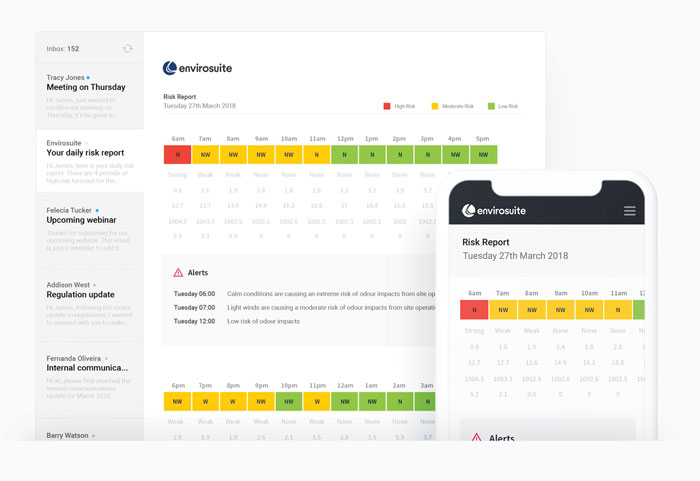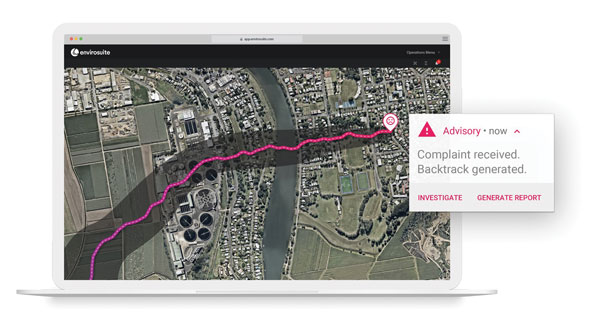The reputation of a waste or wastewater treatment plant could be the difference between its operational growth and significant roadblocks. Environmental intelligence enables facilities to pinpoint problematic sources of odor, get early warning alerts and focus investigations on the right place before emissions leave the site’s boundaries.
By Andres Quijano
Investigating potential emissions sources while trying to limit odor impact can be stressful—especially if you are limited to conventional methods and lack situational awareness. Innovations in the industrial odor management space such as the application of Environmental Intelligence (EI) has made it easier to plan for odor emissions at waste management operations and wastewater treatment plants. New methods are now empowering operators with actionable insights to reduce odor impact, better manage odor complaints and enhance overall efficiency at their sites.

Images courtesy of Envirosuite.
Complicated Compromise Between Operations and Odor Impact
Odor is something that we cannot see and has always been difficult to measure. Traditional methods to manage emissions can be expensive. This is due to cost of maintaining regulatory compliance, operational overheads from manual processing and loss of operational efficiency.
To make matters more difficult, today’s growing populations mean that communities are no longer located miles away from waste treatment facilities. It is becoming more and more complicated for plant operators to minimize community impact without taking a toll on operational activities.
Environmental Intelligence to Improve Efficiencyat the Treatment Facility
Maintenance activities at a waste or wastewater treatment facility are one of the biggest culprits for releasing odor into the atmosphere, leading to complaints from surrounding communities. Even if these activities are carried out in a controlled fashion, rapid changes in weather can still cause an unforeseen nuisance for the neighbors.
However, with an Environmental Intelligence (EI) solution, organizations can easily know when to schedule maintenance activities and avoid excess odor emissions. Operators can get a 72-hour window into the future using insights from predictive emissions and weather models. This enables teams to concentrate work toward periods of minimal emission risk, while staying notified in real time for any potential breach in the future.
Ensure Regulatory Compliance Via Environmental
Intelligence solutions Breaches of compliance regulations from relevant environmental authorities are becoming more and more stringent. Therefore, it is critical for wastewater treatment plants to be armed with a robust system to avoid costly penalties.
Real-time analysis to understand where to focus environmental investigation or getting a bird’s eye view of a site’s odor monitoring network can provide operators with powerful tools to manage odor. Emissions dispersion modeling using site-specific information for early warnings allows operators to act on potential issues and avoid community impact while staying compliant.

complaints in the community.
Earn Community Trust Through Stakeholder Engagement
The reputation of a waste or wastewater treatment plant could be the difference between its operational growth and significant roadblocks. EI solutions enable facilities to pinpoint problematic sources of odor, get early warning alerts and focus investigations on the right place before emissions leave the site’s boundaries.
Make Sense of the ‘Information Avalanche’ Around Odor Using Environmental Intelligence
Odor management strategies using environmental intelligence are now providing wastewater and waste management sites with the ability to make sense of the ‘information avalanche’.
Operational managers are using valuable insights from real-time environmental monitoring systems to ensure compliance obligations are being met under rapidly changing conditions while saving on capital expenditure. | WA
EI in Action
In July 2021, Camden Municipal Utilities Authority (CCMUA) implemented
Envirosuite’s environmental intelligence system to reduce odor risks, respond to communities, and realize environmental justice using real-time odor management
solutions. EI is now providing real-time time analysis of operational issues as well as diagnosis of upset conditions to gain a faster, clearer picture of potential emissions. There are now a growing number of organizations around the world following in their footsteps—
including major wastewater and waste management across North America.
Find out more about the project at www.camdencounty.com/ccmua-platform-to-reduce-odor-nuisances-improve-quality-of-life.
Andres Quijano is currently the Operations Manager for the Americas at Envirosuite. He has more than 15 years of experience creating integrated hardware and software solutions that assist environmental professionals and site operators to optimize their management plans. His experience and passion for software has led him to design solutions that meet the most challenging environmental demands and constantly exceed customers’ expectations.
A pioneer of EI solutions—Envirosuite—has a pedigree of more than three decades working in the odor management space and assisting industrial operations in the community trust through stakeholder engagement. Their EI platform offers real-time monitoring, visualization of exceedance alerts and emissions modeling for waste and wastewater treatment facilities. For more information, visit https://envirosuite.com/wastewater-management-odor-management or https://envirosuite.com/contact.
